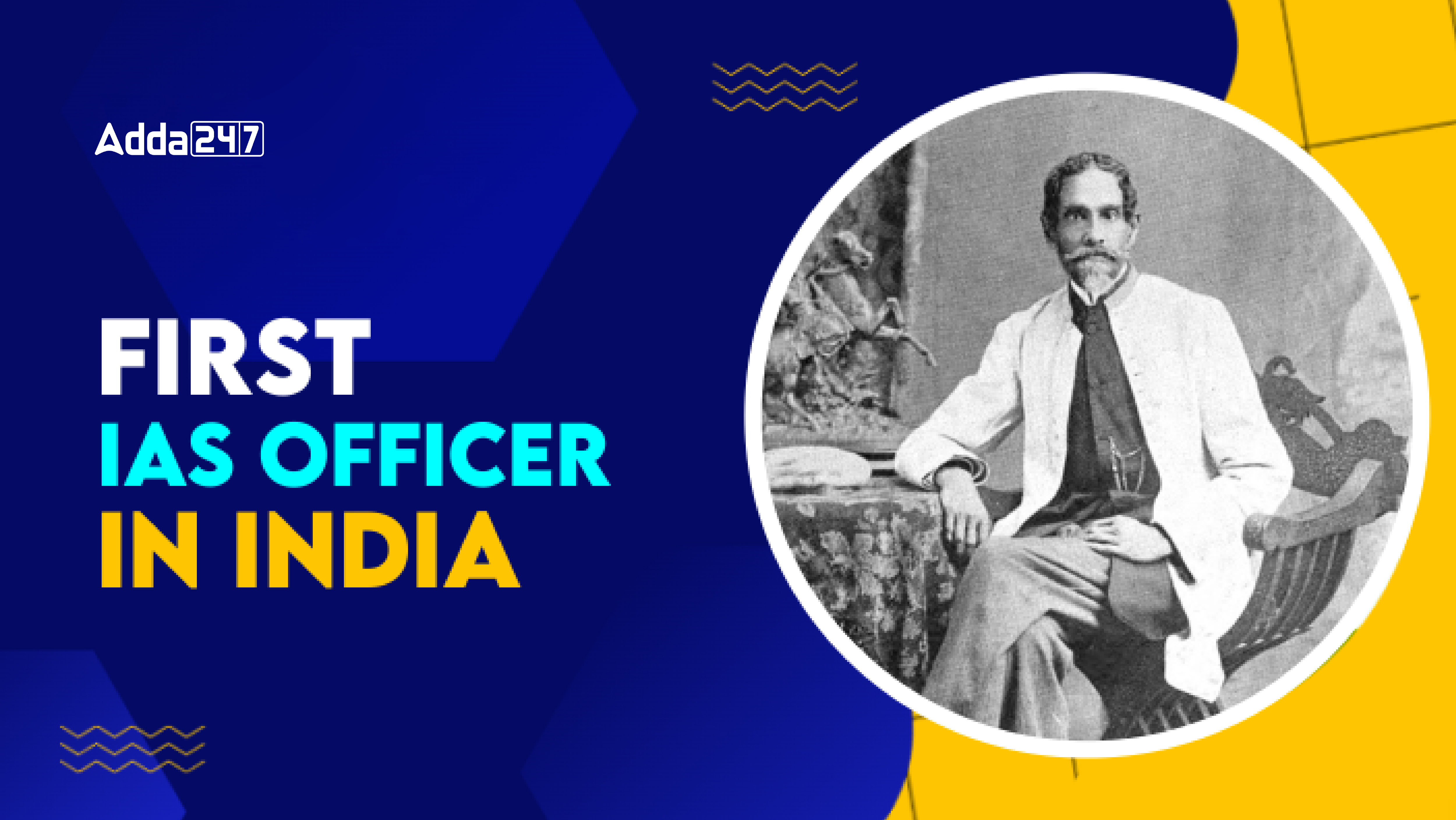Table of Contents
Satyendranath Tagore, who joined the Indian Civil Service (ICS) in 1864, is considered the first IAS officer of India. As the son of Maharshi Debendranath Tagore and Sarada Devi, his achievement inspired many Indians to take the ICS exam. His work as an IAS officer not only involved public service but also the welfare of society.
The IAS is crucial to India’s government, with officers working in various government bodies to carry out policies and manage operations. Understanding the role and history of the IAS is important for those aspiring to join. Satyendranath Tagore’s journey as the first IAS officer not only paved the way for future generations but also marked a significant milestone in India’s civil service history, reflecting dedication, resilience, and the evolving nature of public administration.
First IAS Officer of India
Satyendranath Tagore holds the distinction of being the first Indian Civil Service (ICS) officer, which is widely considered the precursor to the modern Indian Administrative Service (IAS). He joined the service in 1864, paving the way for future generations of Indians to enter the prestigious civil service. Satyendranath Tagore was not just an administrator but a man of many talents. He was also a writer, composer, and social reformer, leaving a lasting legacy beyond his bureaucratic achievements.
| Satyendranath Tagore- Highlights | |
| Birth Date | June 1, 1842 |
| Birthplace | Jorasanko, Kolkata |
| Parents | Maharshi Devendranath Tagore and Sarada Devi |
| Spouse | Jnanadanandini Devi |
| Education | Presidency College, Kolkata |
| Occupation | Civil servant, poet, composer, writer, social reformer & linguist. |
| Known For | Becoming the First IAS Officer of India in 1864, Women’s Welfare, Literary works. |
History of First IAS Officer of India
Satyendranath Tagore (1842-1923) wasn’t just the first Indian Civil Servant (ICS) officer, a role that laid the groundwork for today’s IAS, but a true polymath. Let’s delve into his remarkable story.
Early Life and Family: Born in 1842 into the illustrious Tagore family of Kolkata, Satyendranath was the elder brother of the Nobel laureate Rabindranath Tagore. His father, Debendranath Tagore, was a prominent figure in the Brahmo Samaj, a reformist Hindu movement that influenced Satyendranath’s social conscience.
Education: Satyendranath received his early education at home, studying Sanskrit and Hindi. He was among the first students to appear for the entrance exam of Calcutta University in 1857, later attending Presidency College.
Becoming India’s First IAS Officer: The Indian Civil Service examinations were opened to Indians in the 1850s. Satyendranath, driven by a desire to serve his country, travelled to England in 1862 to compete. He emerged successful in 1863, becoming the first Indian to join the ICS in 1864.
Achievements and Contributions: Satyendranath’s civil service career spanned a decade. He served in various positions across India, his postings exposing him to diverse cultures and languages. This improve his literary pursuits, leading him to write poetry, and songs, and even translate Sanskrit works into Bengali. Notably, his song “Mile Sabe Bharat Santan” (“Come, All Sons of India”) resonated deeply and is considered an early precursor to the Indian national anthem.
Beyond Bureaucracy: Satyendranath was a man of multifaceted talents. He actively championed social reforms, particularly advocating for women’s rights, influenced by the Brahmo Samaj’s ideals. He even faced opposition from his own family for his progressive views on women’s education and travel.
Satyendranath Tagore’s legacy extends far beyond being the first IAS officer. He stands as a symbol of intellectual and social awakening during the Bengal Renaissance, leaving an enduring mark on Indian history.
Literature work by Satyendrnath –
- Sushila O Birsingha
- Bombai Chitra
- Nabaratnamala
- Bouddhadharma
- Striswadhinata
- Amar Balyakotha O Bombai Prabas
- Bharatbarsiyo Ingrej
- Raja Rammohan Roy
- Birsingha
- Shrimadbhagvatgita
- Amar Balyakotha
- Atmakotha
Origin of Civil Services in India
The civil service in India, known as the Indian Civil Service (ICS) from 1858 to 1947, held a prestigious position in administration, attracting many Europeans. Its history and evolution are outlined below:
- During the era of the East India Company, civil services were categorized into covenanted, uncovenanted, and special civil services. The covenanted civil services were replaced by the Indian Civil Services (ICS) in 1858, serving as the highest Indian Civil Service until 1947.
- Initially only Britishers were allowed to give the ICS exam.
- Then in 1850 the exam was opened for Indians but it required to travel to London to give the exam.
- Because of such settlement, Indians were not able to join the ICS.
- In 1863 Satyendranath Tagore became the first Indian to join the ICS.
- Under the Government of India Act 1919, the Indian Civil Services were mentioned in section 32 and were divided into the All-India Services and the Central Services. The Indian Civil Service became a part of the All-India Services.
- Following independence, the Indian Civil Service was divided between India and Pakistan. The Indian segment of the service was renamed the Indian Administrative Service (IAS).
IAS Officers have inspired a generation of youngsters through their dedication and determination to serve society. The new generation should look up to IAS Officers to understand how they can serve society more effectively, fostering positive change and contributing to nation-building. Their commitment to ethical governance and social welfare provides valuable lessons for aspiring civil servants and citizens alike.
Father of Civil Services in India
Charles Cornwallis is known as the “father of Civil Service in India” because he worked to modernize and reform the Indian civil services. While Warren Hastings laid the foundation for India’s civil services, it was Cornwallis who took on the challenge of bringing about the actual change.
Cornwallis established both the covenanted and uncovenanted branches of the Indian Civil Service. Serving as the British Governor-General of India and a British soldier and statesman (1786-1793, 1805), he formally accepted the position of governor-general of India on 23 February 1786. By treating civil servants properly, he established a tradition of law-abiding, incorruptible British administration in India. He also prohibited civil servants from conducting their own business.
Interesting Facts about the Indian Administrative Service
Initially, the ICS recruited candidates exclusively from Oxford and Cambridge, which contributed to its reputation as a premium service. Later, the ICS opened its doors to Indian candidates, leading to the commencement of the Indian Civil Service Examination in India in 1922.
Here are some important facts about the Indian Administrative Service (IAS):
- Recruitment to the Indian Civil Services (ICS) was based solely on merit starting in 1855.
- The Indian Civil Service transformed into its current form after 1947.
- Satyendranath Tagore was the first Indian to join the Civil Service in 1864.
- The highest rank an IAS officer can achieve is Principal Secretary.
- R. Pillai was the first to serve as Cabinet Secretary, holding the position from 1950 to 1953.
- Sardar Vallabhbhai Patel believed that public service would help unite the nation post-independence.
- Anna George Malhotra was India’s first woman IAS officer.
IAS Officer of India Year-wise Topper List
Because becoming an IAS officer is a prestigious job, people greatly respect those who score the highest in the exam. That’s why many people look up to these top scorers to inspire them to work hard in their exam preparation. Here is the list of top scorers from 2014:
| Name of Topper |
Year of Qualification
|
| Ira Singhal | 2014 |
| Tina Dabi | 2015 |
| Nandini K R | 2016 |
| Anudeep Durishetty | 2017 |
| Kanishak Kataria | 2018 |
| Pradeep Singh | 2019 |
| Shubham Kumar | 2020 |
| Shruti Sharma | 2021 |
| Ishita Kishore | 2022 |
Famous IAS Officer in India
Here are some famous IAS Officers of India below:
- Anna Rajam Malhotra: The first woman IAS officer of India, Anna Rajam Malhotra is celebrated for breaking many gender stereotypes during her service.
- Vinod Rai: Serving as the 11th Comptroller and Auditor General of India, Vinod Rai is credited with uncovering the multi-billion-dollar 2G Spectrum scam.
- T N Seshan: Known for implementing significant electoral reforms, T N Seshan served as the 10th Chief Election Commissioner of India and received the Ramon Magsaysay Award for government service.
- D Subbarao: As the 22nd Governor of the Reserve Bank of India, D Subbarao is noted for systematically implementing land transfer regulations during his tenure as an IAS officer.
- Amitabh Kant: Formerly the 2nd CEO of the public policy think tank NITI Aayog, Amitabh Kant is currently serving as India’s G20 Sherpa to the Prime Minister.
- Ira Singhal: The first differently-abled woman to top the civil services exam, Ira Singhal has focused on issues such as education, disability, gender disparity, and skill development.
- Ashok Khemka: Known for his actions against land mafia and corruption, Ashok Khemka has been transferred 55 times in his 30-year career as of 2023.
- Durga Shakti Nagpal: Durga Shakti Nagpal gained prominence for her extensive campaign against corruption and illegal sand mining during her posting in Gautam Buddh Nagar.



 TSPSC Group 1 Question Paper 2024, Downl...
TSPSC Group 1 Question Paper 2024, Downl...
 TSPSC Group 1 Answer key 2024 Out, Downl...
TSPSC Group 1 Answer key 2024 Out, Downl...
 UPSC Prelims 2024 Question Paper, Downlo...
UPSC Prelims 2024 Question Paper, Downlo...





